Smartphone photography has revolutionized the way we capture images, offering remarkable quality through advanced hardware and software innovations. With user-friendly features and affordable access, smartphones empower individuals to engage in photography, making it an accessible art form for everyone. As technology continues to evolve, devices like the Apple iPhone 14 Pro, Samsung Galaxy S23 Ultra, and Google Pixel 7 Pro stand out for their exceptional capabilities in producing stunning visuals.
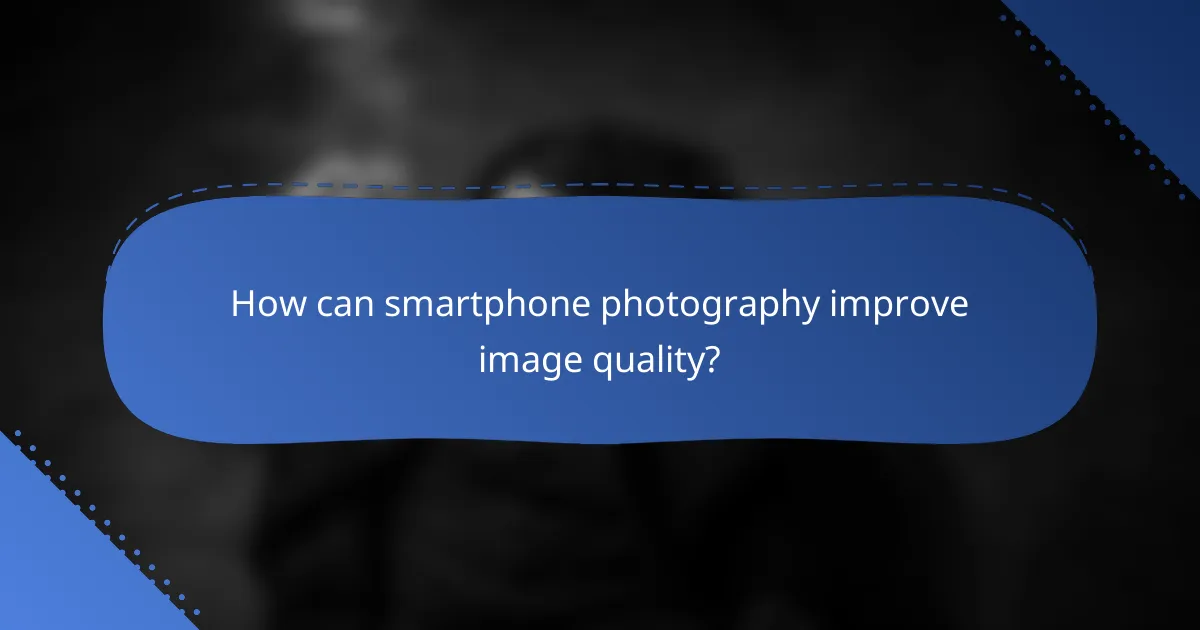
How can smartphone photography improve image quality?
Smartphone photography can significantly enhance image quality through various technological advancements. These improvements stem from hardware innovations and sophisticated software techniques that work together to produce clearer, more vibrant images.
High-resolution sensors
High-resolution sensors are crucial for capturing detailed images. Modern smartphones often feature sensors with resolutions exceeding 12 megapixels, allowing for sharper photos with more detail. This increase in pixel count enables users to crop images without losing clarity, making it easier to focus on specific subjects.
When selecting a smartphone, consider the sensor size as well; larger sensors typically gather more light, which can enhance overall image quality, especially in challenging lighting conditions.
Advanced image processing algorithms
Advanced image processing algorithms play a vital role in enhancing smartphone photography. These algorithms analyze images to adjust colors, contrast, and sharpness, resulting in more visually appealing photos. Features like HDR (High Dynamic Range) help balance exposure levels between bright and dark areas, providing a more realistic representation of the scene.
Smartphones often use machine learning to improve image processing, allowing for features like portrait mode and scene recognition, which automatically optimize settings for different environments.
Optical image stabilization
Optical image stabilization (OIS) helps reduce blurriness caused by camera shake, especially in low-light conditions or while capturing moving subjects. OIS works by physically adjusting the camera lens to counteract movement, resulting in clearer images. This feature is particularly beneficial for video recording, where stability is crucial for a professional look.
When choosing a smartphone, look for models that include OIS, as it can significantly enhance the quality of both photos and videos, especially in dynamic situations.
Low-light performance enhancements
Low-light performance enhancements are essential for capturing quality images in dim environments. Many smartphones now incorporate larger apertures and improved sensor technology to allow more light to enter the camera. This results in brighter images with less noise, which is often a challenge in low-light photography.
Additionally, features like Night Mode utilize longer exposure times and advanced processing to create clear, detailed images in darkness. Users should experiment with these settings to maximize their smartphone’s capabilities in low-light situations.
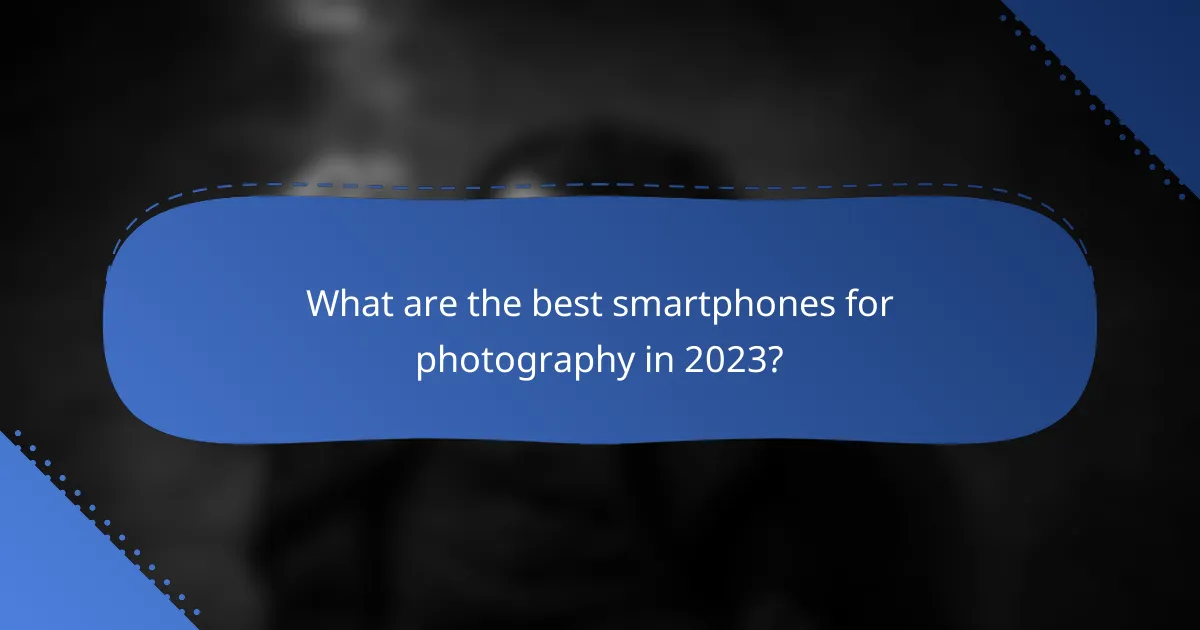
What are the best smartphones for photography in 2023?
The best smartphones for photography in 2023 combine advanced camera technology with user-friendly features. Key contenders include the Apple iPhone 14 Pro, Samsung Galaxy S23 Ultra, and Google Pixel 7 Pro, each offering unique strengths for capturing high-quality images.
Apple iPhone 14 Pro
The Apple iPhone 14 Pro is renowned for its exceptional camera system, featuring a triple-lens setup that includes a wide, ultra-wide, and telephoto lens. This smartphone excels in low-light conditions, thanks to its Night mode and advanced computational photography capabilities.
Users appreciate the intuitive interface and seamless integration with editing apps, making it easy to enhance photos. The ProRAW format allows for greater editing flexibility, appealing to both casual users and photography enthusiasts.
Samsung Galaxy S23 Ultra
The Samsung Galaxy S23 Ultra stands out with its impressive 200 MP main camera, offering incredible detail and versatility. It includes multiple lenses, such as ultra-wide and periscope telephoto, enabling users to capture a wide range of scenes from various distances.
This smartphone’s Space Zoom feature allows for high-quality zoom shots, making it ideal for capturing distant subjects. Additionally, the camera app provides extensive manual controls, appealing to users who prefer a hands-on approach to photography.
Google Pixel 7 Pro
The Google Pixel 7 Pro is celebrated for its outstanding image processing capabilities, producing vibrant and true-to-life colors. Its software-driven features, such as Magic Eraser and Motion Mode, simplify the editing process and enhance the overall photography experience.
With a strong emphasis on AI and machine learning, the Pixel 7 Pro excels in capturing stunning photos in challenging lighting conditions. The user-friendly interface and automatic updates ensure that users benefit from the latest photography enhancements without hassle.
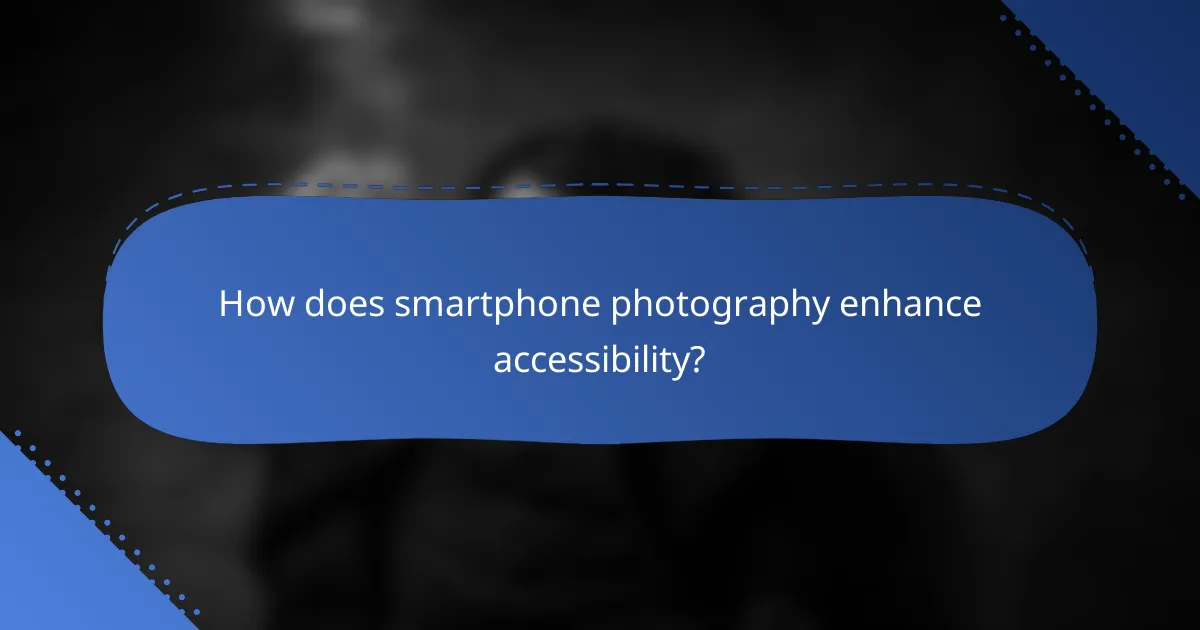
How does smartphone photography enhance accessibility?
Smartphone photography enhances accessibility by providing affordable and user-friendly tools that allow anyone to capture high-quality images. With the widespread availability of smartphones, more people can engage in photography without the need for expensive equipment or extensive training.
Affordability of devices
Smartphones are generally more affordable than traditional cameras, making them accessible to a wider audience. Many models are available at various price points, often starting from low hundreds of USD, which is significantly less than professional camera systems that can cost thousands.
This affordability allows individuals from different economic backgrounds to participate in photography, fostering creativity and expression among diverse groups. Additionally, many smartphones come with built-in cameras that offer impressive features, reducing the need for additional investments.
Ease of use for beginners
Smartphone cameras are designed with user-friendliness in mind, making them ideal for beginners. Most smartphones feature intuitive interfaces, automatic settings, and guided modes that help users take great photos without needing extensive knowledge of photography techniques.
For those just starting, the ability to point and shoot simplifies the learning process. Users can experiment with different settings and styles without feeling overwhelmed, allowing them to develop their skills gradually.
Availability of editing apps
The availability of numerous editing apps further enhances the accessibility of smartphone photography. Many apps are free or low-cost, allowing users to edit their photos easily and creatively, often with just a few taps.
Popular apps like Snapseed, Lightroom Mobile, and VSCO offer powerful editing tools that can transform ordinary images into professional-looking photos. This accessibility to editing software empowers users to refine their work and express their artistic vision without needing advanced technical skills.

What professional opportunities arise from smartphone photography?
Smartphone photography opens various professional avenues, allowing individuals to leverage their skills in creative fields. With the accessibility of high-quality cameras on smartphones, many can transition into roles that were once reserved for traditional photographers.
Social media influencer roles
Smartphone photography is a cornerstone for social media influencers, who rely on captivating visuals to engage their audiences. By mastering smartphone photography techniques, influencers can create stunning content that attracts followers and brand partnerships.
To succeed, focus on consistency in style and quality. Use natural lighting and experiment with different angles to enhance your images. Engaging storytelling through visuals can significantly boost your influence and reach.
Freelance photography gigs
Freelance opportunities in photography are increasingly available for those who utilize smartphones effectively. Many businesses seek photographers for events, product shoots, or promotional content, often favoring the convenience and immediacy that smartphone photography provides.
When pursuing freelance gigs, build a portfolio showcasing your best smartphone shots. Networking through local events or online platforms can help you find clients. Be prepared to negotiate rates, which can vary widely based on project scope and location.
Content creation for brands
Brands are increasingly turning to smartphone photography for their marketing campaigns, recognizing its authenticity and relatability. Content creators can collaborate with brands to produce visually appealing images that resonate with target audiences.
To attract brand partnerships, develop a unique aesthetic and maintain a strong online presence. Understanding a brand’s identity and aligning your photography style with their vision is crucial. Consider offering packages that include a mix of photography and social media promotion to enhance your value proposition.
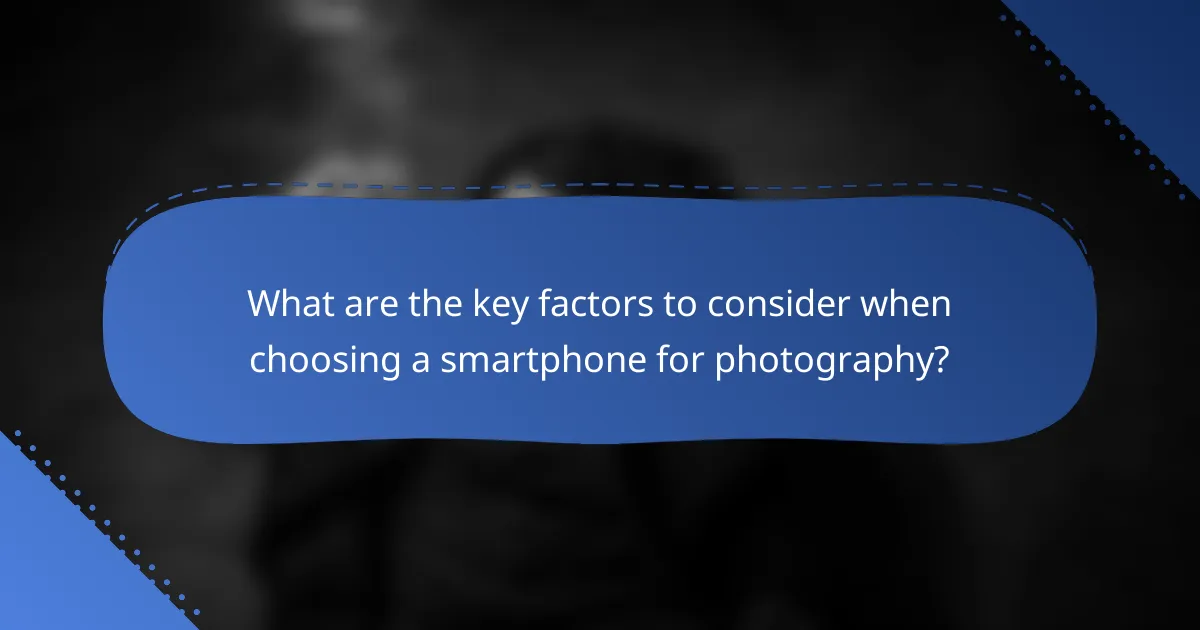
What are the key factors to consider when choosing a smartphone for photography?
When selecting a smartphone for photography, key factors include camera specifications, software features, and battery life. Each of these elements significantly impacts the overall quality and usability of the device for capturing images.
Camera specifications
Camera specifications are crucial as they determine the quality of photos you can take. Look for features such as megapixel count, aperture size, and sensor type. A higher megapixel count can provide more detail, while a larger aperture allows for better performance in low light.
Consider the number of lenses available as well. Smartphones with multiple lenses—like wide-angle, telephoto, and macro—offer greater versatility for different photography styles. For example, a device with a dual or triple camera setup can enhance your creative options.
Software features
Software features play a significant role in smartphone photography, influencing how images are processed and edited. Look for built-in editing tools, filters, and modes like night mode or portrait mode that enhance your photography experience. These features can help you achieve professional-looking results without needing additional apps.
Additionally, consider the user interface and ease of use. A smartphone with intuitive camera controls and settings can make a big difference, especially for beginners. Some devices also offer advanced options like manual controls for exposure and focus.
Battery life
Battery life is essential for photographers who spend extended periods capturing images. A smartphone with a long-lasting battery ensures you can shoot throughout the day without frequent recharging. Look for devices that offer at least a full day of usage on a single charge, especially if you plan to use power-intensive features like video recording or high-resolution photography.
Keep in mind that battery performance can vary based on usage patterns. If you’re frequently using the camera, consider models with fast charging capabilities or those that support power-saving modes to extend battery life during critical moments.
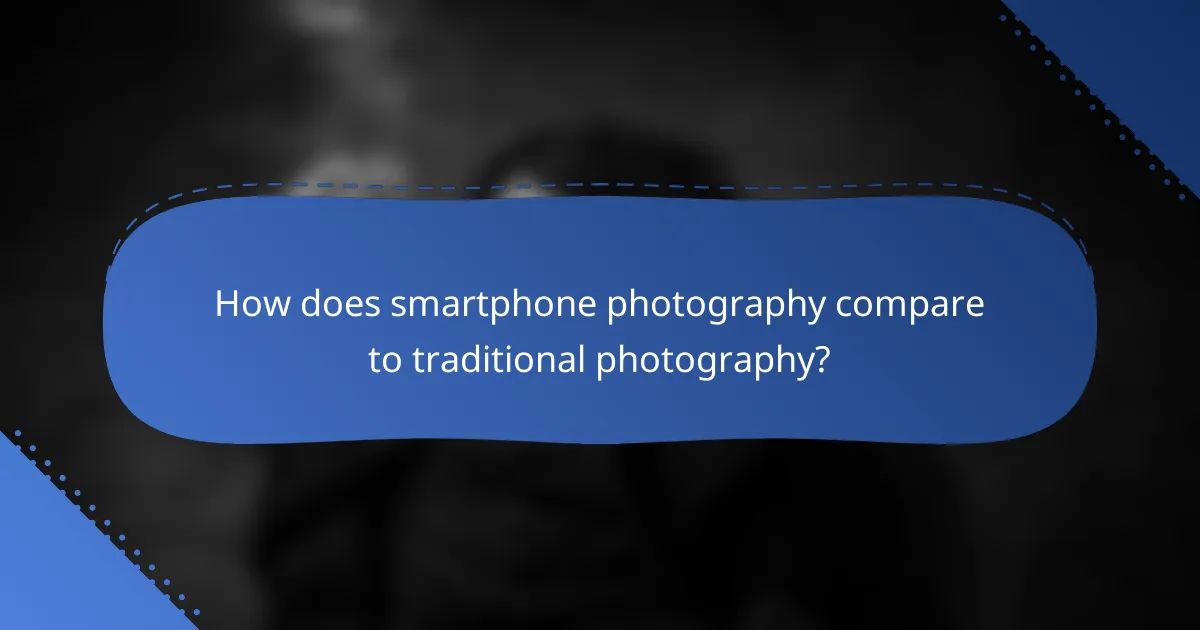
How does smartphone photography compare to traditional photography?
Smartphone photography offers a unique blend of accessibility and quality that often rivals traditional photography. While traditional cameras may provide superior image quality in certain conditions, smartphones excel in convenience and ease of use, making photography more approachable for everyone.
Portability and convenience
Smartphones are designed for portability, allowing users to capture images anytime and anywhere. Unlike traditional cameras, which can be bulky and require additional equipment, smartphones fit easily in pockets and bags, making spontaneous photography effortless.
The convenience of smartphones extends beyond size; they come equipped with powerful editing tools and instant sharing capabilities. Users can quickly edit photos with built-in apps and share them on social media platforms, enhancing the immediacy of the photographic experience.
However, it’s essential to consider the trade-offs. While smartphones are convenient, they may not perform as well in low-light situations compared to traditional cameras. For serious photographers, understanding these limitations can help in choosing the right tool for specific scenarios.
